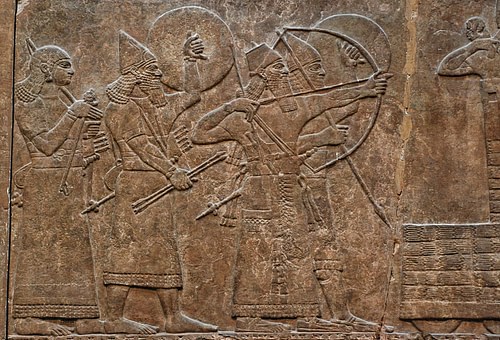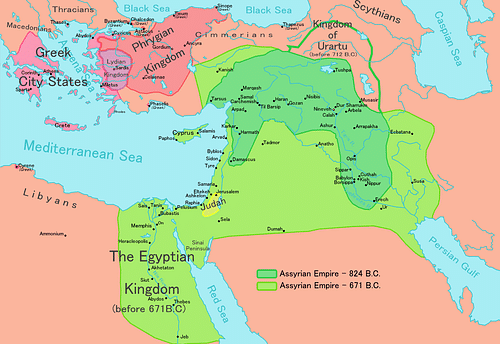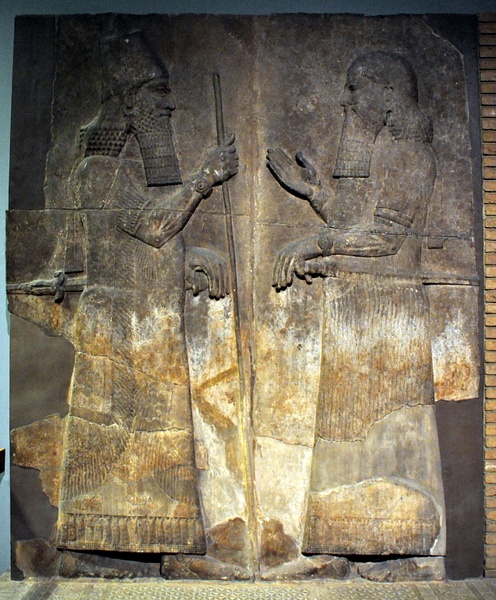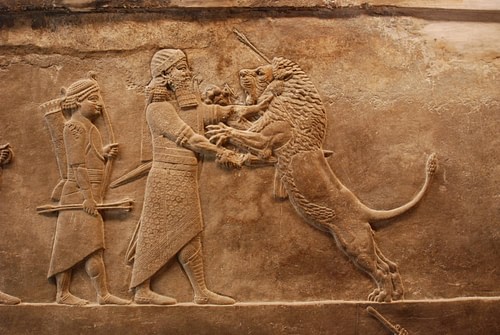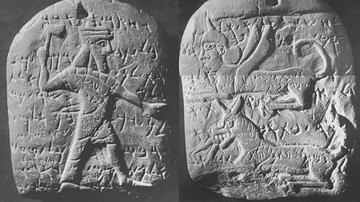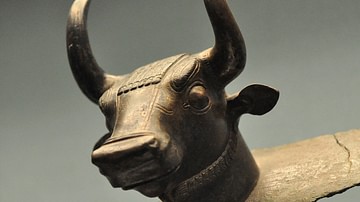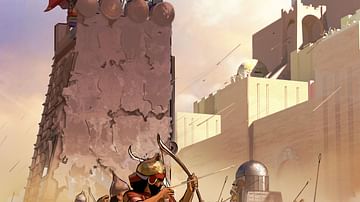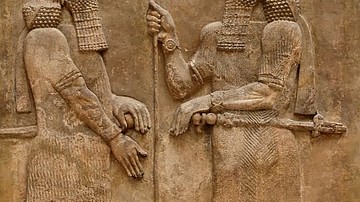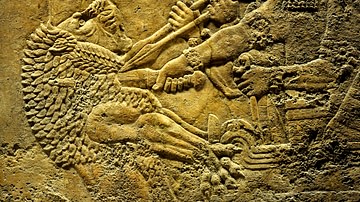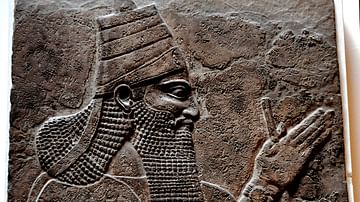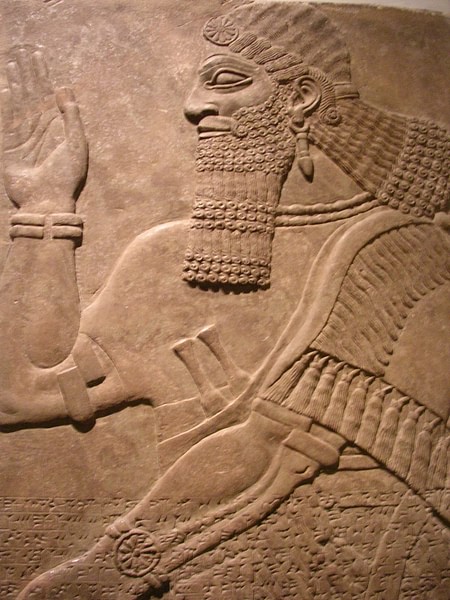
The Neo-Assyrian Empire (912-612 BCE) was the final stage of the Assyrian Empire, stretching throughout Mesopotamia, the Levant, Egypt, Anatolia, and into parts of Persia and Arabia. Beginning with the reign of Adad Nirari II (912-891 BCE), the Neo-Assyrian kings made great territorial expansions to forge the greatest empire in the world up to that time.
The Assyrians fielded the most effective fighting force in the world and were the first to be armed with iron weapons, whose tactics in battle made them invincible. Their political and military policies have also given them the long-standing reputation for cruelty and ruthlessness though this has come to be challenged in recent years, as it is now argued they were neither more nor less cruel than other ancient empires such as that of Alexander the Great or of Rome.
The kings of the empire, such as Tiglath Pileser III, Shalmaneser V, Sargon II, Sennacherib, and Esarhaddon, are mentioned a number of times throughout the Bible as the enemies of the Israelites, although the inscriptions of the Assyrians and the books of the Bible differ, sometimes dramatically, on how events unfolded between the two nations. This is most notable in Sennacherib's inscriptions regarding the conquest of Judah and the account given in the biblical Book of Isaiah 37, II Chronicles 32:21, and II Kings 18-19.
The Assyrians themselves did not refer to this phase of their empire as Neo-Assyrian but regarded it as simply another development in their history. The historian Gwendolyn Leick writes, “According to the Assyrian King List, there was no break between the rulers of the mid-second millennium and those of the first millennium” (126). Neo-Assyrian is a modern designation coined by historians and based on an interpretation of ancient inscriptions that suggest a change in the way the empire was now ruled.
The date for the beginning of this period is also contested as some scholars claim it begins with “a new assertiveness after the political turmoil associated with the Aramaean invasions in the 12th and 11th centuries” (assigning the dates of 934-610 BCE) while others maintain it begins with the reign of Adad Nirari II in 912 BCE (Leick, 126). There are even other scholars who claim the true founding of the empire begins with Tiglath Pileser III in 745 BCE. This same situation holds for the end of the period, in that some scholars cite the end of the Neo-Assyrian Empire at 612 BCE with the fall of Ashur and Nineveh, while others claim 610 BCE as the final date because all of the cities had by that time been destroyed.
The Reputation for Cruelty
The Neo-Assyrian Empire is the one most familiar to students of ancient history as it is the period of the largest expansion of the empire, and the kings of this period are the ones most often mentioned in the Bible. It is also the era which most decisively gives the Assyrian Empire the reputation it has for ruthlessness and cruelty. The scholar Paul Kriwaczek writes:
Assyria must surely have among the worst press notices of any state in history. Babylon may be a byname for corruption, decadence and sin but the Assyrians and their famous rulers, with terrifying names like Shalmaneser, Tiglath-Pileser, Sennacherib, Esarhaddon and Ashurbanipal, rate in the popular imagination just below Adolf Hitler and Genghis Khan for cruelty, violence, and sheer murderous savagery. (208)
This reputation is further noted by scholar Simon Anglim and others. Anglim writes:
While historians tend to shy away from analogies, it is tempting to see the Assyrian Empire, which dominated the Middle East from 900-612 BC, as a historical forebear of Nazi Germany: an aggressive, murderously vindictive regime supported by a magnificent and successful war machine. As with the German army of World War II, the Assyrian army was the most technologically and doctrinally advanced of its day and was a model for others for generations afterwards. The Assyrians were the first to make extensive use of iron weaponry [and] not only were iron weapons superior to bronze, but could be mass-produced, allowing the equipping of very large armies indeed. (12)
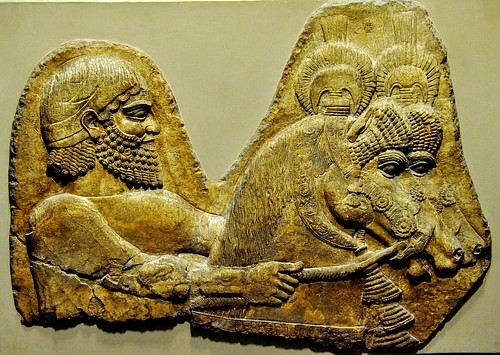
While the reputation for decisive, ruthless, military tactics is understandable, the comparison with the Nazi regime is less so. Unlike the Nazis, the Assyrians treated the conquered people they relocated well and considered them Assyrians once they had submitted to central authority. There was no concept of a 'master race' in Assyrian policies; everyone was considered an asset to the empire whether they were born Assyrian or were assimilated into the culture. Kriwaczek notes:
In truth, Assyrian warfare was no more savage than that of other contemporary states. Nor, indeed, were the Assyrians notably crueler than the Romans, who made a point of lining their roads with thousands of victims of crucifixion dying in agony. (209)
The only fair comparison between Nazi Germany in WWII and the Assyrians is the efficiency of the military and the size of the army, and this same comparison could be made with ancient Rome.
These massive armies still lay in the future, however, when the first king of the Neo-Assyrian Empire came to power. The rise of the king Adad Nirari II (r. 912-891 BCE) brought the kind of revival Assyria needed at that time. The Assyrians had lost territory, prestige, and power following both the Bronze Age Collapse (c. 1200 BCE) and invasions by the Aramaeans, the Amorites, and the Sea Peoples. Adad Nirari II re-conquered the lands that had been lost and secured the borders. The defeated Aramaeans were executed or deported to regions within the heartland of Assyria and assimilated into the culture.
He also conquered Babylon but, learning from the mistakes of the past (as when King Tukulti-Ninurta I sacked Babylon in c. 1225 and was assassinated for it) refused to plunder the city and, instead, entered into a peace agreement with the king in which they married each other's daughters and pledged mutual loyalty. Their treaty would secure Babylon as a powerful ally, instead of a perennial problem, for the next 80 years.
Military Expansion & the Revision of God
The kings who followed Adad Nirari II continued the same policies and military expansion. Tukulti Ninurta II (r. 891-884 BCE) expanded the empire to the north and gained further territory toward the south in Anatolia, while Ashurnasirpal II (r. 884-859 BCE) consolidated rule in the Levant and extended Assyrian rule through Canaan. Ashurnasirpal II moved the capital from Ashur to his newly built city of Kalhu, which he adorned with over 41 types of trees he carried back from his campaigns.
Kalhu was built through slave labor also brought back from these campaigns, which had been successful in subjugating a significant amount of territory. In battle, he had employed the Assyrian's most common method of conquest: siege warfare, which would begin with a brutal assault on the city. Anglim writes:
More than anything else, the Assyrian army excelled at siege warfare, and was probably the first force to carry a separate corps of engineers…Assault was their principal tactic against the heavily fortified cities of the Near East. They developed a great variety of methods for breaching enemy walls: sappers were employed to undermine walls or to light fires underneath wooden gates, and ramps were thrown up to allow men to go over the ramparts or to attempt a breach on the upper section of wall where it was the least thick. Mobile ladders allowed attackers to cross moats and quickly assault any point in defences. These operations were covered by masses of archers, who were the core of the infantry. But the pride of the Assyrian siege train were their engines. These were multistoried wooden towers with four wheels and a turret on top and one, or at times two, battering rams at the base. (186)
Advancements in military technology were not the only, or even the primary, contribution of the Assyrians as, during this same time, they made significant progress in medicine, building on the foundation of the Sumerians and drawing on the knowledge and talents of those who had been conquered and assimilated. Ashurnasirpal II made the first systematic lists of plants and animals in the empire and brought scribes with him on campaign to record new finds.
Schools were established throughout the empire but were only for the sons of the wealthy and nobility. Women were not allowed to attend school or hold positions of authority even though, earlier in Mesopotamia, women had enjoyed almost equal rights. The decline in women's rights correlates to the rise of Assyrian monotheism. As the Assyrian armies campaigned throughout the land, their god Ashur went with them but, as Ashur was previously linked with the temple of that city and had only been worshipped there, a new way of imagining the god became necessary in order to continue his worship and enlist his aid in other locales. Kriwaczek notes:
One might pray to Ashur not only in his own temple in his own city, but anywhere. As the Assyrian empire expanded its borders, Ashur was encountered in even the most distant places. From faith in an omnipresent god to belief in a single god is not a long step. Since He was everywhere, people came to understand that, in some sense, local divinities were just different manifestations of the same Ashur. (231)
This unity of vision of a supreme deity helped to further unify the regions of the empire. The different gods of the conquered peoples, and their various religious practices, became absorbed into the worship of Ashur; he was recognized as the one true god who had been called different names by different people in the past but who now was clearly known and could be properly worshipped as the universal deity. Regarding this, Kriwaczek comments:
Belief in the transcendence rather than immanence of the divine had important consequences. Nature came to be desacralized, deconsecrated. Since the gods were outside and above nature, humanity – according to Mesopotamian belief created in the likeness of the gods and as servant to the gods – must be outside and above nature too. Rather than an integral part of the natural earth, the human race was now her superior and her ruler. The new attitude was later summed up in Genesis 1:26: `And God said, Let us make man in our image, after our likeness: and let him have dominion over the fish of the sea, and over the fowl of the air, and over the cattle, and over all the earth, and over every creeping thing that creepeth upon the earth' That is all very well for men, explicitly singled out in that passage. But for women it poses an insurmountable difficulty. While males can delude themselves and each other that they are outside, above, and superior to nature, women cannot so distance themselves, for their physiology makes them clearly and obviously part of the natural world…It is no accident that even today those religions that put most emphasis on God's utter transcendence and the impossibility even to imagine His reality should relegate women to a lower rung of existence, their participation in public religious worship only grudgingly permitted, if at all. (229-230)
The Assyrian culture became increasingly cohesive with the expansion of the empire, the new understanding of the deity, and the assimilation of the people from the conquered regions. Shalmaneser III (r. 859-824 BCE) expanded the empire up through the coast of the Mediterranean and received tribute from the wealthy Phoenician cities of Tyre and Sidon.
He also defeated the Armenian kingdom of Urartu, at least temporarily, which had long proved a significant nuisance to the Assyrians. Following his reign, however, the empire erupted in civil war as the king Shamshi Adad V (r. 824-811 BCE) fought with his brother for control. Although the rebellion was put down, expansion of the empire halted after Shalmaneser III.
The regent Sammu-Ramat (also given as Shammuramat, the inspiration for the legendary queen Semiramis) held the throne for her young son Adad Nirari III from c. 811-806 BCE and, in that time, secured the borders of the empire and organized successful campaigns to put down the Medes and other troublesome populaces in the north.
When her son came of age, she was able to hand him a stable and sizeable empire which Adad Nirari III then expanded further. Following his reign, however, his successors preferred to rest on the accomplishments of others and the empire entered another period of stagnation. This was especially detrimental to the military which languished under kings like Ashur Dan III and Ashur Nirari V.
The Rise of the Neo-Assyrian Empire
The empire was revitalized by Tiglath Pileser III (r. 745-727 BCE) who reorganized the military and restructured the bureaucracy of the government. According to Anglim:
Tiglath Pileser III carried out extensive reforms of the army, reasserted central control over the empire, reconquered the Mediterranean seaboard, and even subjugated Babylon. He replaced conscription [in the military] with a manpower levy imposed on each province and also demanded contingents from vassal states. (14)
He also defeated the kingdom of Urartu, which had again risen to trouble Assyrian rulers, and subjugated the region of Syria. According to some scholars, the Neo-Assyrian Empire actually begins with Tiglath Pileser III. Leick, for example, notes:
In the time between 745 and 705 BC, the Assyrian Empire took shape. This was the result not only of renewed military expansion but also of new administrative structures that ensured much tighter political and fiscal control. (127)
Under Tiglath Pileser III's reign, the Assyrian army became the most effective military force in history up until that time and would provide a model for future armies in organization, tactics, training, and efficiency.
Tiglath Pileser III was followed by Shalmaneser V (r. 727-722 BCE) who continued the king's policies but was not as effective in military campaigns. His successor, Sargon II (r. 722-705 BCE), was a brilliant military leader and administrator who expanded the empire further than any king before him. Even though Sargon II's rule was contested by nobles who claimed he had seized the throne illegally, he maintained the cohesion of the empire, expanded the borders, improved legislation and administration, and kept the royal treasury filled through his conquests.
Following Tiglath Pileser III's lead, Sargon II was able to bring the empire to its greatest height politically and militarily. Sargon II founded the Sargonid Dynasty (722-612 BCE) which would rule the Assyrian Empire until its fall.
The Sargonid Dynasty
Sargon II was followed by his son Sennacherib (r. 705-681 BCE) who campaigned widely and ruthlessly, conquering Israel, Judah, and the Greek provinces in Anatolia. His siege of Jerusalem is detailed on the 'Taylor Prism', a cuneiform block describing Sennacherib's military exploits, discovered in 1830 by Britain's Colonel Taylor, in which he claims to have captured 46 cities and trapped the people of Jerusalem inside the city until he overwhelmed them.
His account is contested, however, by the version of events described in the biblical book of II Kings, chapters 18-19, II Chronicles 32:21, and Isaiah 37, where it is claimed that Jerusalem was saved by divine intervention and Sennacherib's army was driven from the field. The biblical account does relate the Assyrian conquest of the region, however.
Sennacherib's military victories increased the wealth of the empire beyond what Sargon II had accomplished, even though his reign was marred by persistent military campaigns against Babylon and the Elamites. He moved the capital from Sargon's city of Dur-Sharrukin to Nineveh and built what was known as “the Palace without a Rival”. He beautified and improved upon the city's original structure, planting orchards and gardens. Scholar Christopher Scarre writes:
Sennacherib's palace had all the usual accoutrements of a major Assyrian residence: colossal guardian figures and impressively carved stone reliefs (over 2,000 sculptured slabs in 71 rooms). Its gardens, too, were exceptional. Recent research by British Assyriologist Stephanie Dalley has suggested that these were the famous Hanging Gardens, one of the Seven Wonders of the Ancient World. Later writers placed the Hanging Gardens at Babylon, but extensive research has failed to find any trace of them. Sennacherib's proud account of the palace gardens he created at Nineveh fits that of the Hanging Gardens in several significant details. (231)
Babylon had been a persistent problem throughout Sennacherib's reign, however, and he finally grew tired of dealing with it. Ignoring the lessons of the past, and not content with his great wealth and the luxury of the city, Sennacherib drove his army against Babylon, sacked it, and looted the temples. As earlier in history with Tukulti-Ninurta I (r. 1244-1208 BCE), the looting and destruction of the temples of Babylon was seen as the height of sacrilege by the people of the region and also by Sennacherib's sons who assassinated him in his palace at Nineveh in order to placate the wrath of the gods.
Sennacherib had chosen his youngest son, Esarhaddon, to succeed him in 683 BCE and this did not sit well with his older brothers. While their motive in murdering their father could well have been their desire for power (and to cut off their younger brother's hopes for the crown), they would have needed some kind of justification for the act, and their father's sack of Babylon provided the rationalization.
Esarhaddon (r. 681-669 BCE) took the throne, defeated his brother's factions in a six-week civil war, and then executed his brother's families, associates, and anyone who had joined against him. With his rule now secure, one of his first projects was to rebuild Babylon. He issued an official proclamation that claimed that Babylon had been destroyed by the will of the gods owing to the city's wickedness and lack of respect for the divine.
Nowhere in his proclamation does it mention Sennacherib or his role in the destruction of the city but makes clear that the gods chose Esarhaddon as the divine means for restoration:
Once during a previous ruler's reign there were bad omens. The city insulted its gods and was destroyed at their command. They chose me, Esarhaddon, to restore everything to its rightful place, to calm their anger, and soothe their rage.
The empire flourished under his reign. He successfully conquered Egypt, which Sennacherib had tried and failed to do (because, according to Herodotus II.141, field mice ate through the strings of Sennacherib's archer's bows, their quivers, and the soldier's shield straps the night before battle). Esarhaddon established the empire's borders as far north as the Zagros Mountains (modern day Iran) and as far south as Nubia (modern Sudan) with a span including the Levant (modern day Lebanon to Israel) through Anatolia (Turkey).
His successful military campaigns and careful maintenance of the government provided the stability for advances in medicine, literacy, mathematics, astronomy, architecture, and the arts. Historian Will Durant writes:
In the field of art, Assyria equaled her preceptor Babylonia and in bas-relief surpassed her. Stimulated by the influx of wealth into Ashur, Kalakh, and Nineveh, artists and artisans began to produce – for nobles and their ladies, for kings and palaces, for priests and temples – jewels of every description, cast metal as skilfully designed and finely wrought as on the great gates at Balawat, and luxurious furniture of richly carved and costly woods strengthened with metal and inlaid with gold, silver, bronze, or precious stones. (278)
In order to secure the peace, Esarhaddon entered into vassal treaties with the Persians and the Medes, requiring them to submit in advance to his successor. Further, Esarhaddon's mother, Zakutu (l. c. 728-c.668 BCE), the powerful queen dowager, also issued her Loyalty Treaty of Naqi'a-Zakutu that compelled the Assyrian court and the subject territories to accept Ashurbanipal as king and support his reign in accordance with Esarhaddon's wishes.
These measures ensured the easy transition of power when Esarhaddon died in 669 BCE on campaign in Egypt and rule passed to the last great Assyrian king, Ashurbanipal (r. 668-627 BCE). Ashurbanipal was the most literate of the Assyrian rulers and is probably best known in the modern day for the vast library he collected at his palace at Nineveh.
Though a great patron of the arts and culture, Ashurbanipal could be just as ruthless as his predecessors in securing the empire and intimidating his enemies. Kriwaczek comments:
Which other imperialist would, like Ashurbanipal, have commissioned a sculpture for his palace with decoration showing him and his wife banqueting in their garden, with the struck-off head and severed hand of the King of Elam dangling from trees on either side, like ghastly Christmas baubles or strange fruit? (208)
Ashurbanipal decisively defeated the Elamites, completed his father's conquest of Egypt, and expanded the empire further to the east and north. Recognizing the importance of preserving the past, he then sent envoys to every point in the lands under his control and had them retrieve or copy the books of that city or town, bringing all back to Nineveh for the royal library. While not the first king to collect books, he was the first to make such a collection a priority.
Decline & Fall
Ashurbanipal ruled over the empire for 42 years and, in that time, campaigned successfully and ruled efficiently. The empire had grown too large, however, and the regions were overtaxed. Further, the vastness of the Assyrian domain made it difficult to defend the borders. As great in number as the army remained, there were not enough men to keep garrisoned at every significant fort or outpost.
When Ashurbanipal died in 627 BCE, the empire began to fall apart. His successors Ashur-etli-Ilani, Sin-Shar-Ishkun, and Ashur-uballit II were unable to hold the territories together and regions began to break away. The rule of the Assyrian Empire was seen as overly harsh by its subjects, in spite of whatever advancements and luxuries being an Assyrian citizen may have provided, and former vassal states rose in revolt.
In 612 BCE Nineveh was sacked and burned by a coalition of Babylonians, Persians, Medes, and Scythians, among others (as was Ashur and the other cities of the Assyrians). The destruction of the palace brought the flaming walls down on the library of Ashurbanipal and, although it was far from the intention, preserved the great library, and the history of the Assyrians, by baking hard and burying the clay tablet books. Kriwaczek writes:
Thus did Assyria's enemies ultimately fail to achieve their aim when they razed Ashur and Nineveh in 612 BCE, only fifteen years after Ashurbanipal's death: the wiping out of Assyria's place in history. (255)
Still, the destruction of the great Assyrian cities was so complete that, within two generations of the empire's fall, no one knew where the cities had been. The ruins of Nineveh were covered by the sands and lay buried for the next 2,000 years.
The Assyrians were remembered, however, because of the records of the Greek and Roman writers and also due to their mention in the Bible. Archaeological interest in Mesopotamia was fueled in the 19th century by the desire to corroborate biblical narratives of the Old Testament with historical evidence. The Assyrians, who had been masters of the land in their day, again played an important role in history by drawing the attention of archaeologists and scholars to the Mesopotamian region where the whole of Mesopotamian culture was eventually revealed.
Prior to the 19th century, the Sumerians were unknown, as were many of the myths, legends, and historical events which are recognized today as so important. These stories are available to modern-day readers because of the preservation of the books. The clay tablets that were discovered beneath the walls of Nineveh and elsewhere revealed to the modern world the myths, legends, and histories of the people of Mesopotamia and, with their discovery, provided a new understanding of world history and culture.
